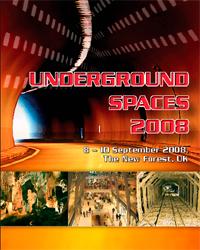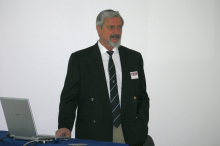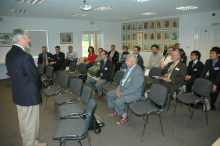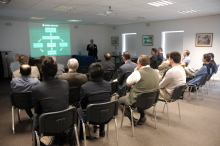First International Conference on Underground Spaces - Design, Engineering and Environmental Aspects
![]() 8 - 10 September 2008
8 - 10 September 2008
The New Forest, UK
Overview
 The 1st International Conference on Underground Spaces took place recently at Ashurst Lodge, the Campus of the Wessex Institute of Technology, organised by Professor Dimitris Kaliampakos of National University of Athens (NTUA); Professor Petr Prochazka of the Czech Technical University and Professor Carlos A Brebbia of the Wessex Institute (WIT).
The 1st International Conference on Underground Spaces took place recently at Ashurst Lodge, the Campus of the Wessex Institute of Technology, organised by Professor Dimitris Kaliampakos of National University of Athens (NTUA); Professor Petr Prochazka of the Czech Technical University and Professor Carlos A Brebbia of the Wessex Institute (WIT).
Underground spaces are becoming increasingly important for a wide diversity of uses by society. They range from classical excavations to subway constructions, underground sport halls, power stations, waste repositories, underground cities, and many others. Their construction or techniques are also very varied, from open air excavation to newly developed injection methods.
It is to be believed that population growth and the demand for better accommodation and leisure facilities, combined with a desire to improve the landscape, will result in the need to develop more underground spaces for leisure facilities and accommodation. This phenomenon, which started in countries subjected to extreme climates is now becoming more widespread.
The response of the underground structures on the imposed loadings depends on a number of parameters that sometimes are too complex or not fully understood, resulting in budget overruns or even failures that lead to the loss of life or property.
Plans for underground spaces to be used as storage facilities have, in many cases, proved highly controversial. This is particularly the case when proposing to build a chemical or nuclear depository, but also applies to general waste. Serious environmental issues can arise in these cases. The issue is particularly pressing in our society and it is a matter of urgency to share common experiences in this field.
The Conference was convened to discuss not only the structural and environmental aspects but also the trends regarding the utilisation of underground spaces. The Meeting discussed problems and issues that are common to different types of underground spaces to share experiences and lessons learnt in a variety of disciplines.
Opening Address
 The Meeting was opened by Professor Carlos Brebbia, Director of WIT and Co-Chairman of the Conference who explained the importance of these types of meetings in relation to the work of the Institute. WIT’s objective, Carlos said, is to act as a Centre for exchange of knowledge at an international level. He stressed the commitment of WIT to collaborating with other institutions, universities and industrial partners from all over the world and invited the participants to find out more about the work of the Institute.
The Meeting was opened by Professor Carlos Brebbia, Director of WIT and Co-Chairman of the Conference who explained the importance of these types of meetings in relation to the work of the Institute. WIT’s objective, Carlos said, is to act as a Centre for exchange of knowledge at an international level. He stressed the commitment of WIT to collaborating with other institutions, universities and industrial partners from all over the world and invited the participants to find out more about the work of the Institute. Professor Dimitris Kaliampakos from NTUA, another Co-Chairman of the Conference, also addressed the participants and welcomed them to the Conference.
Following this, Professor Kaliampakos gave his keynote address entitled “Underground Space Development: setting modern strategies”. Professor Kaliampakos presented a series of interesting examples of underground spaces ranging from those of antiquity to very recent developments. Some of the latter are of outstanding quality and defy the preconceptions that people used to have of underground spaces. Professor Kaliampakos also referred to the current population trends within big cities continuing to grow. This is the decisive factor promoting underground development and the only question is when and how these developments will take place, rather than if. As the price of urban land and limits to expansion grow, the trend will be towards underground developments.
 Underground space is a new commodity in this regard, due to the scarcity of urban land. The new situation requires environmental economics to be taken into consideration.
Underground space is a new commodity in this regard, due to the scarcity of urban land. The new situation requires environmental economics to be taken into consideration. In many cases, underground constructions are driven by the availability of space created by mining which makes these spaces very economical. In urban areas, the situation is different but also favourable to underground construction in view of the high cost of space there.
Professor Kaliampakos ended his presentation by stressing his conviction that the time has arrived for the development of underground spaces.
Invited Presentations
Other invited presentations during the Conference were:- “Blast impact on structures of underground parking” by PP Prochazka, Czech Technical University, Prague
- “Artificial intelligence in underground development: a study of TBM performance” by A Benardos, National Technical University of Athens, Greece
- “Fracture propagation, aperture and arrest in layered rocks: field observations and modelling” by A Gudmundsson, Royal Holloway College, London
 Professor Gudmundsson explained the type of fractures that are most frequently found in structural geology. Some of the applications shown were for tunnel type structures, where understanding the fractures is crucial to the behaviour and stability of tunnels. He applied the programme BEASY, developed by Wessex Institute, to model the cracks’ stress behaviour and compute the permeability properties of the material. This investigation resulted in a different position for a tunnel built in Iceland, avoiding the unstable layers and increasing the depth to avoid the possibility of water leaks into the tunnel. These recommendations, which resulted in a more expensive but safer construction, were followed in practice.
Professor Gudmundsson explained the type of fractures that are most frequently found in structural geology. Some of the applications shown were for tunnel type structures, where understanding the fractures is crucial to the behaviour and stability of tunnels. He applied the programme BEASY, developed by Wessex Institute, to model the cracks’ stress behaviour and compute the permeability properties of the material. This investigation resulted in a different position for a tunnel built in Iceland, avoiding the unstable layers and increasing the depth to avoid the possibility of water leaks into the tunnel. These recommendations, which resulted in a more expensive but safer construction, were followed in practice. The case of propagating hydrofractures in multilayered materials was also studied using BEASY. The path of fracture varies in function of the composite-like material properties of the rock layers. Different paths required different levels of energy. The opening of the cracks is important to determine the permeability properties of the media, a condition of fundamental importance in reservoirs, dams and oil exploitation. Professor Gudmundsson’s address was followed by a lively discussion.
Excursions
A series of functions and visits were organised to promote interaction among the participants, as well as to show them places of interest around the New Forest.
During the lunch break on the first day, the delegates were taken to Buckler’s Hard, a place of special interest, as it was there that many ancient wooden men of war were built, with timber from the Forest. They included some of Nelson’s ships as well as others. The history of the shipyard is described through a series of exhibits in the Museum attached to the site. The delegates enjoyed lunch there in the beautiful setting of the Beaulieu River.
A special visit to Fort Nelson near Portsmouth was arranged. The Portsdown Hill forts were built in the 1860s to protect Portsmouth dockyard and the naval installation from bombardment by the then modern rifled guns. From the hill, where Fort Nelson is located, the whole of Portsea Island and its surroundings may be seen.
Fort Nelson which is situated 250 feet above sea level, is six-sided, with ditches protected by two storey demi-caponiers on the east and west angles, and a two storey double caponier at the north salient. The Fort was built in such a way as to minimise the elevation to the enemy by having an extensive network of tunnels and underground spaces, built below ground level. This method of construction was unique at the time.
Above each of the caponiers is a mortar battery each accommodating three guns. The counterscarp walls remain as originally planned, without revetment. The interior of the fort was altered considerably in 1938, when the parade was concreted and rows of magazines for anti-aircraft ammunition were constructed, although most of these buildings have now been demolished. The western gorge wall was cut through and a new gateway was inserted, to permit lorries to enter and leave the fort. The fort is now the home of the Royal Armouries collection of artillery and displays an outstanding collection of outstanding old armoury and guns. Fort Nelson is part of the Royal Armouries, the most famous of which is the Tower of London. Another is located in Louisville, Kentucky, USA.
The visit was followed by an excellent banquet in the old Officers Mess of the Fort. The Mess is located on the upper floor of the Fort and commands a view of Portsmouth Bay. A local catering service provided an excellent dinner accompanied by good wines. At the end of the dinner, a lively discussion took place, lead by the Co-Chairman, Dimitris Kaliampakos, regarding the philosophical aspects behind the design and development of underground spaces, which he felt was a new frontier of human endeavour.
Organising Commitee
The Organising Committee met over dinner to discuss the conference and ways in which the Meeting can be improved in the future. It was felt that the main difficulty in convening a first meeting on the topic of Underground Spaces including Design Engineering and Environmental Aspects, was the need to break into a new area within a highly inter-disciplinary conference. It ought to be simpler now to explain the concepts, particularly as underground spaces are gaining acceptability and it is an emerging topic of research and applications.
Publication of Papers
The proceedings of Underground Spaces: Design, Engineering and Environmental Aspects, 224pp (ISBN: 1-84564-125-2) are available in hard back from WIT Press priced at £73/US$146/€109.50. Orders can be placed by telephone: +44 (0) 238 029 3223, fax: +44 (0) 238 029 2853, e-mail: This email address is being protected from spambots. You need JavaScript enabled to view it. or via the WIT Press web site at www.witpress.com
Papers from the conference will also be hosted online in the WIT eLibrary as volume 102 of WIT Transactions on The Built Environment (ISSN: 1743-3509). For more details visit the WIT eLibrary at www.witpress.com


 Wessex Institute
Wessex Institute